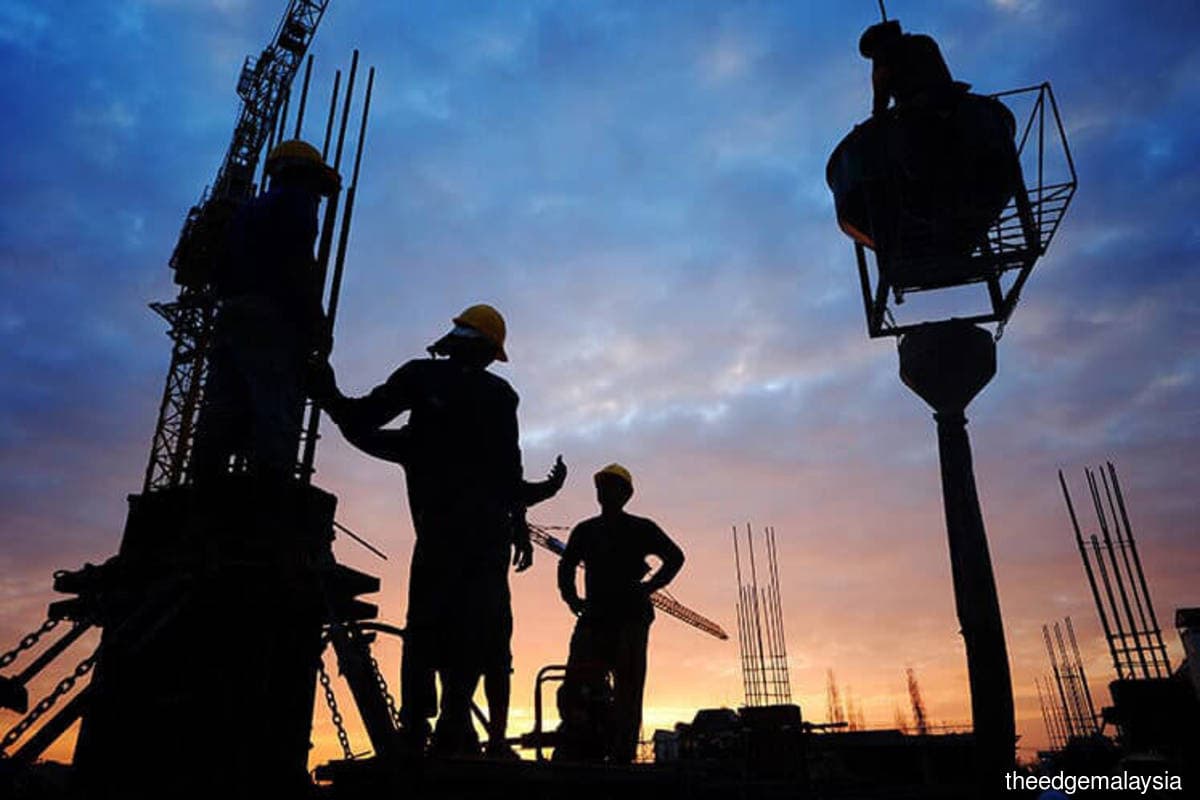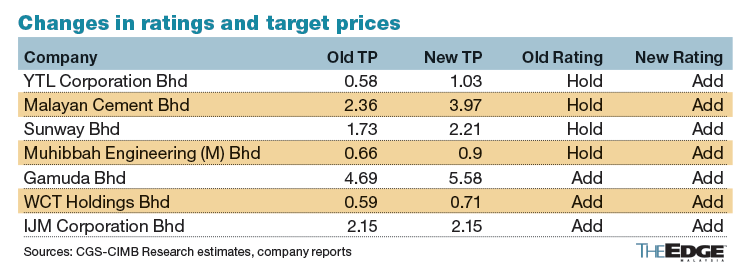
KUALA LUMPUR (June 2): CGS-CIMB Securities has lifted the construction and materials sector to “overweight”, from “neutral”, on the back of better visibility of contract flow and political stability post the 15th general election, as well as growing numbers of overseas projects, followed by improved balance sheets across larger contractors.
In a note on May 25, CGS-CIMB analyst Chong Tjen-San said that expectations on the sector are widely “muted and reflected” in their valuations, which are trading at mean levels.
"Compelling sector valuations at 11x CY24F P/E and 0.9x CY24F P/BV (-1 s.d. below mean since 2005), on the back of a 2-year EPS CAGR of 13% (CY22-24F)
“Net profit expectations also appear fairly muted, with an average increase of 5.3% in FY23F and 3.9% in FY24F for Bloomberg’s consensus’ earnings forecasts for our universe year-to-date, (consensus’ forecast changes have been more company specific vs sector driven),” said Chong.
He also highlighted four companies that are the sector’s top picks — Gamuda Bhd, Sunway Construction Group Bhd (SunCon: new initiation), Sunway Bhd and YTL Corporation Bhd (YTL Corp).
Upon raising the sector status to “overweight”, Chong also upgraded the target prices (TPs) of several stocks:
- YTL Corp — “hold” to “add”; TP of RM1.03, from 58 sen
- Malayan Cement Bhd — “hold” to “add”; TP of RM3.97, from RM2.36
- Sunway Bhd — “hold” to “add”; TP of RM2.21, from RM1.73
- Muhibbah Engineering (M) Bhd — “hold” to “add”; TP of 90 sen, from 66 sen
- Gamuda — unchanged at “add”; TP of RM5.58, from RM4.69
- WCT Holdings Bhd — unchanged at “add”; TP of 71 sen from 59 sen
- IJM Corporation Bhd — unchanged at “add” and TP remains at RM2.15
The effects on the sector are driven by several catalysts; the higher budget for development expenditure, up 34% year-on-year to RM96.5 billion under the February 2023 Budget, is a sign that the government is focused on construction sector-led growth. The Mass Rapid Transit (MRT) 3 and the revival of the High-Speed Rail (HSR) are two significant projects.
Additionally, Chong expects overseas projects to be more apparent moving forward, as he observes that contractors have been making more conscious efforts to diversify their portfolios and accrue overseas projects, rather than relying on Malaysia’s public sector and slowing private sector.
Thus, the balance sheets of larger contractors appear stronger now, compared to the last two years, which enables a strong appetite for private finance initiatives (PFI) projects, according to CGS-CIMB.
Company-centric
The research house’s rating on YTL Corp is largely based on the company’s higher TP (based on a 20% holding company discount to sum-of-the-parts (SOP) valuation). Chong also believes that YTL Corp’s presence in industrial warehouses is gaining traction, while its cement and construction businesses are key beneficiaries of a revival in construction spending.
“Our core net profit forecasts are 210%/218%/339% of Bloomberg consensus’ forecasts for FY23F/24F/25F due to our updated higher earnings forecasts for YTL Power,” Chong added.
As at the time of writing, YTL Corp’s share price was 1.5 sen or 1.67% higher, at 91.5 sen giving it a market capitalisation of RM10.03 billion.
For Malayan Cement, the revised TP of RM3.97 is based on a higher discounted cash flow (DCF) with a weighted average cost of capital (WACC) of 7.6% and terminal growth (TG) of 3%.
Chong supplemented that the re-rating catalysts for Malayan Cement are a recovery in the property market and a resurgence in public sector government spending, such as the HSR. CGS-CIMB earnings are 101%/126%/128% of Bloomberg consensus’ forecasts for FY2023F/2204F/2025F.
As of writing, Malayan Cement share price rose seven sen or 2.63% higher, giving them a market capitalisation of RM3.58 billion.
Subsequently, Sunway Bhd’s TP of RM2.21 is based on a 10% holding company discount to SOP (previously revised net asset value (RNAV)-based TP of RM1.73), with earnings forecast at 116%/118%/121% of Bloomberg consensus’ forecasts for FY2023F/2024F/2025F.
Chong sees stronger-than-expected property sales in FY2023F and faster-than-expected listing of its healthcare business as drivers to Sunway Bhd’s re-rating.
As at the time of writing, Sunway Bhd's share price increased three sen or 1.89% lower at RM1.56, giving them a market capitalisation of RM7.8 billion.
As for Muhibbah, Chong believes Muhibbah to be a prime beneficiary of the resurgence in global travel, primarily from mainland Chinese tourists, from their 21% stake in the Cambodian airport concession. Muhibbah’s higher SOP-based TP of 90 sen translates into a price-earnings ratio (P/E) of 13 times CY2024F.
Muhibbah’s recent wins have been Petronas-driven, totalling RM678 million from three projects from the second half of 2022 to date, he elaborated.
Thus, CGS-CIMB gave an earnings forecast at 40%/81%/248% of Bloomberg consensus’ forecasts for FY2023F/2024F/2025F.
Muhibbah's share price, as at the time of writing, were one sen or 1.54% lower, giving them a market capitalisation of RM461.72 million.
For Gamuda, CGS-CIMB lifted their SOP-based TP to RM5.58, translates to a P/E of 17 times FY2024F. Factored into the decision was Gamuda’s RM21 billion orderbook, alongside their RM8 billion new order wins this year.
“Core net profit forecasts are largely in line at 107%/96%/94% of Bloomberg consensus’ estimates for FY2023F/2024F/2025F,” Chong added.
Gamuda's share price was one sen, equivalent to 0.23%, higher at RM4.27, giving them a market capitalisation of RM11.3 billion.
Meanwhile, the biggest push for WCT’s revised SOP-based TP of 71 sen (translating into a P/E of 11 times CY2024F) lies in the Subang Airport Regeneration Plan, which is currently awaiting approval from the Ministry of Finance, which upon approval, should foster up to RM2 billion worth of new orders and provide WCT with a recurring revenue stream.
As at the time of writing, WCT's share price remained unchanged at 41 sen, with a market capitalisation of RM574.35 million.
Both IJM’s “add” call and TP of RM2.15 (translating into a P/E of 17.6 times CY2024F) remained unchanged, with earnings forecast at 87%/101%/112% of Bloomberg consensus’ forecasts for FY2023F/2024F/2025F.
Key re-rating catalysts are a potential sizeable East Coast Rail Link (ECRL) contract win, an MRT 3 above-ground contract win given their prior experiences with MRT 1 and 2, and more investments in the Malaysia-China Kuantan Industrial Park (MCKIP), said Chong.
IJM's share price increased one sen or 0.61% to RM1.63, giving them a market capitalisation of RM5.95 billion.
Chong added that “key re-rating catalysts are continuity in the MRT 3 project, the revival of the HSR, and further inroads into overseas projects.”
Possible risks to construction and materials
Chong said that key downside risks that would impact the sector would be; (i) political instability, (ii) rising raw material costs and labour, and (iii) the lack of government funding.
“In our view, the upcoming state elections would be the litmus test for the current Unity Government on its sustainability and ability to push through reforms and policies,” the research house said.
Potential increases in raw materials, such as steel, diesel and cement, would present additional costs to contractors. However, larger contractors are likely more insulated from higher raw material costs, given their ability to lock in prices via bulk buying and holding more inventory.
“The biggest impediment for the sector is the elevated federal government debt levels and contingent liabilities, which amount to RM1.5tr (RM1.5 trillion). The debt-to-GDP ratio was 60.4% in December 2022, rising to 80.9% if contingent liabilities are included,” CGS-CIMB added.
This gives little headroom to allocating funding for construction projects with the ceiling set at 65%, and little room to roll out large-scale construction projects.
However, CGS-CIMB expects more PFI/PPP (public-private partnership) projects such as the potential HSR, which should benefit contractors with stronger balance sheets.

